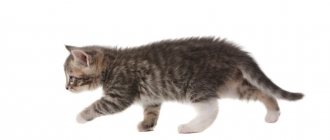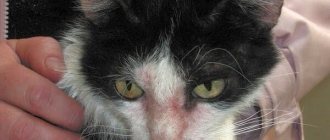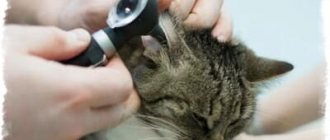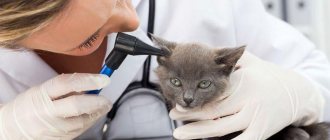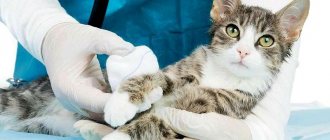02/25/2021 17,042 Diseases and treatment of cats
Author: Olga
Each cat has its own character. It often manifests itself in her “talkativeness.” There are pets that constantly try to attract attention by purring or meowing. But even if a cat doesn’t vocalize often, as soon as he loses it, any owner will notice it. The article discusses the reasons why a cat loses its voice and provides recommendations for solving this problem.
[Hide]
Description
The appearance of hoarseness is a disruption in the functioning of the vocal cords, swelling of the throat, and the growth of a tumor when it puts pressure on surrounding tissues. The voice may change - it becomes rattling, hoarse. Symptoms appear periodically or constantly. Sometimes the voice disappears completely. This may be preceded by anesthesia (used during the period of sterilization, castration, and other operations). While the pet returns to consciousness, it is weak and cannot make sounds. This condition goes away on its own without treatment.
How does voice loss manifest in cats?
Every cat owner knows well when the pet uses its sound activity. Typically, pets use their voice to convey certain information:
- ask for food, reminding you that feeding time has arrived;
- asked to leave or enter the room;
- remind you of yourself, demanding attention;
- signal the onset of readiness for procreation.
If in a familiar situation nothing is heard instead of the usual “meow,” the owner should pay attention to the cat. If an animal opens its mouth, but the sound is either very quiet or absent at all, it means that its voice has disappeared. When the problem does not go away after a few hours, it is worth looking for its cause.
Causes
Most often, the cause of hoarseness in an animal is viral and infectious diseases. Periodically occur against the background of hypothermia or a cold. For example, if in cold weather the pet walked for a long time on the street. Viral diseases are transmitted by airborne droplets.
Causes leading to hoarseness
| Disease or provoking factors | Description of the pathology |
| Otitis | Inflammation of the middle or inner ear with subsequent complications. Otitis media appears in cats exposed to drafts or due to infectious pathologies. The disease also appears in pets that are poorly cared for by their owners. Wax begins to accumulate in the ears, hair grows, and foreign objects can get into the ear canal. |
| Rhinotracheitis | Viral pathology affecting the respiratory system. Otherwise, the pathology is called feline herpes, caused by the FHV-1 virus. More often the disease affects kittens or young pets, less often it manifests itself in adults. |
| Laryngitis (sore throat) | The cause of hoarseness is inflammation of the throat mucosa, leading to swelling of the larynx. This affects the ligaments and the cat cannot make normal sounds. |
| Calcivirosis | The disease even leads to complete loss of voice. The mucous membranes of the mouth, upper respiratory tract, nose, and larynx are affected. Severe pathology provokes the appearance of arthritis or pneumonia. Cats get sick more often in houses where many animals live. Calcivirosis (like plague) is always accompanied by muteness and hoarseness. |
| Allergic reactions | This is accompanied by swelling of the throat. The clearance decreases, it becomes difficult for the animal to breathe, the voice changes to hoarse, and may disappear completely. Swelling is dangerous because it blocks breathing and leads to death. Your cat should be taken to the vet immediately at the first sign of hoarseness. |
| Anaphylactic shock | This is the most dangerous type of allergic reaction. The larynx swells rapidly, the voice is lost, and sometimes the owner may not have time to take the pet to the veterinarian. |
| Intoxication of the body | Poisoning can be caused by food, chemicals, insect poison, and disinfectants. |
| Getting foreign objects into the mouth | Mechanical damage to the walls appears. More often they are injured by toys or fish bones; they may swallow a spruce needle or twig. Sometimes the wound becomes inflamed, then, in addition to hoarseness, irreversible processes begin in the body. |
| Rabies | This is a fatal viral disease. The virus is transmitted through saliva. If vaccination is not carried out on time, the pet dies. |
| Dry or dirty air | The voice may begin to hoarse from the air filled with tobacco smoke. Nicotine has a negative effect on the ligaments. My throat is dry. The animal begins to wheeze and cannot utter sounds at all. Very dry air has the same effect. |
Hoarseness sometimes becomes a sign of the appearance of serious pathologies - leukemia, immunodeficiency. The diseases are deadly and treatment must be started as quickly as possible. However, only a veterinarian can carry out the diagnosis. Some consequences (for example, wounds of the larynx, purulent inflammation) appear for a long time in the form of wheezing. Stress, emotional distress, and travel can lead to hoarseness.
First aid at home
If your cat has lost her voice, you should not ignore it. It is necessary to immediately examine the animal's mouth. If you find a foreign object in your throat, you must remove it immediately. But you should do this yourself only if the owner is sure that his actions will not harm the animal even more.
If you cannot get the foreign object out on your own, you should immediately contact a veterinarian. You should not delay this, because a sharp object can get into the gastrointestinal tract, and then the animal will face more serious consequences.
If the cat's throat looks good: there is no damage or inflammation, and there are no other symptoms of the disease, nothing needs to be done. You should wait a little and watch the cat. If everything is normal, then the voice will soon recover on its own. If the animal does not make any sounds for a long time, it is better to go to the clinic for a preventive examination.
Treatment depending on the cause
Treatment for a hoarse voice directly depends on the cause of the symptom. If it is a tumor, then therapy is aimed at eliminating the main pathology. When the cause is a foreign body in the throat, it is removed by a veterinarian in a hospital setting. Removing the item yourself may cause serious complications or worsen the condition. Injections, IV drips, anesthesia, and wound treatment may also be required.
Reason: diseases
Vaccination is used to treat viral diseases (rabies, distemper, etc.). The cat is vaccinated, which prevents the spread of pathology and provokes the appearance of antibodies. For angina, Diazolin and Tavigil are given, which reduce swelling and pain. The dosage is calculated from the children's version, taking into account the weight of the pet.
Reason: dehydration
When a cat becomes dehydrated, the mucous membranes dry out. As a result, it becomes painful for the animal to swallow food, the surface may crack, wounds appear, and the meowing becomes hoarse. To avoid such manifestations, it is important to ensure that the cat has clean water available.
Reason: allergies
To eliminate allergy symptoms, you must first determine what caused the reaction. Symptoms are triggered by food, chemicals, and air fresheners. Allergies can be caused by tobacco smoke. In this case, it is necessary to humidify the air daily. In other cases, the veterinarian prescribes antiallergic drugs (for example, Suprastin). The products are selected taking into account the characteristics of the body and the allergen.
Reason: poisoning
If a hoarse voice appears due to poisoning with toxic substances, you need to give the animal fresh milk. When he cannot drink on his own, pour the product into his cheek. Milk can be replaced with a decoction of chamomile, yarrow or St. John's wort or saline solution. Before examination by a veterinarian, a sorbent is given.
Sometimes hoarseness in cats is associated with the period of mating games - the animals lose their voice. Then it recovers on its own. However, if hoarseness is accompanied by the presence of additional negative symptoms, the pet should be shown to a doctor. This will avoid complications, identify serious pathology in time, prescribe timely treatment, and sometimes save the cat’s life.
Colds, infections, viruses
A cat, like a person, is susceptible to colds; it can be attacked by numerous infections and viruses. The main route of transmission of such ailments is airborne; often the disease occurs in an animal due to its long stay in unfavorable weather conditions, from hypothermia or exposure to a draft.
A cat will not be able to meow fully if he has signs of illness.:
- Otitis or inflammation of the ear - the development of a pathological process in the animal’s ear is accompanied by severe pain, it can affect the larynx, where the animal’s speech apparatus is located, which makes it much more difficult for it to reproduce sounds;
- Sore throat, when the disease occurs, characteristic signs arise - the animal’s voice begins to disappear; if you open its mouth and examine it, swelling and inflammation of the mucous membranes, the presence of a sufficient amount of mucus covering the vocal cords will be noticeable;
- Rhinotracheitis, signs that can be suspected are discharge from the eyes and nose, first serous, then mucous, purulent; the cause of its development is infection with feline herpesvirus type 1;
- Calicivirus is a viral pathology in which ulcers of a watery structure appear on the pet’s larynx and tongue, the process is accompanied by severe pain, the animal loses the ability to swallow food and make sounds.
The cat becomes lethargic, may open its mouth silently, refuse to eat for several days, its nose may become dry - such symptoms are a reason for an urgent visit to the veterinary clinic, examination of the animal, and prescription of medications.
© shutterstock
First aid and pet treatment
If you notice signs of muteness in your cat, observe his behavior. If a previously calm pet begins to show aggression, and a playful one becomes lethargic, conduct an initial examination yourself, and then consult a doctor.
Emergency help at home
If you notice signs of sudden muteness, try to help your pet as quickly as possible. Procedure:
- Examine your cat's mouth and larynx. Check to see if there is a piece of food or a sharp object stuck there. If so, don't try to remove it yourself. Fix the animal's head in one position and take it to the veterinarian.
- Swelling in the throat is a sign of laryngitis. Until you contact a specialist, give your cat an antihistamine in a dosage for a small child.
- At the first signs of poisoning, take your four-legged friend outside and give him fresh water. If you know a suspected factor of intoxication (paint, plant, household chemicals), take to the doctor something that will help determine the composition of the substance (packaging or flower leaf).
The cat has lost his voice - do not delay finding out the cause and prescribing treatment, sometimes only professional help can save the animal.
Visit to a specialist
Upon arrival at your appointment, describe in detail the symptoms of the disease. Try to answer the questions:
- Approximate date and time when the voice disappeared.
- Prerequisites (drafts, home renovations, spraying substances from cans around the cat).
- Symptoms: nausea, vomiting, general condition, frequency of bowel movements, salivation, wheezing, thirst, etc.
Having identified the disease, the veterinarian will carry out the necessary procedures and prescribe treatment - injections, tablets or ointments. He will tell you how to care for your pet at home and, if necessary, prescribe a diet. By following the doctor's recommendations, you will restore your cat's voice in a couple of weeks.
Signs of wheezing
So, when a cat meows, it exhibits shortness of breath. Wheezing is a complex of bubbling noises that indicate health problems. Rarely it can be caused by a cold. But first, if the cat is hoarse, let’s look at its different types.
Wet
The cause is the accumulation of sputum in the bronchi of the pet. Mucus is formed due to an active inflammatory process.
Air passes through the phlegm, which leads to the formation of bubbles. They burst quickly. The result is a wet, gurgling wheeze. In turn, this variety differs in the size of the bubbles. Small ones appear with bronchopneumonia or pulmonary infarction. The medium ones create the effect of air being blown through a straw. The main causes are hypersecretion of mucus or pneumosclerosis.
The last type of bubbles is the most dangerous. The pet wheezes a lot. He has difficulty breathing. The cat's usual voice changes greatly. Occurs when there is swelling of the lung or a large accumulation of mucus with a weak cough reflex.
Dry
Typically divided into whistling or buzzing. It occurs as a result of obstruction, compression of the lungs by a newly formed tumor due to the influence of allergies. The air swirls, has difficulty passing through the lumen and creates wheezing. When the bronchi narrow unevenly, wheezing occurs.
The abundance of mucus blocks the air flow and a buzzing sound occurs. In any case, a hoarse cat or kitten is a serious cause for concern.
ATTENTION! In the digital age, many owners record an audio file of their animal wheezing or coughing to show it to the veterinarian. This is done in case the cat does not experience breathing problems at the clinic.
But the disease cannot always be identified by obvious signs - coughing or wheezing. Let's note other reasons:
- Refusal to eat
- Diarrhea
- Unsteady gait, restless behavior
- Blue gum tint
- Rapid breathing with open mouth
Blocking of the pharynx with a foreign object
An object, a piece of food, or a sharp bone getting stuck in a cat's throat is a common reason why she loses her voice or develops severe hoarseness. The situation is complicated by the fact that the animal is not only unable to independently free itself from a foreign body, its fear, desperate, instinctive attempts to remove the object by coughing or vomiting lead to severe trauma to the tissues of the respiratory organs, larynx, and esophagus. The presence of such damage contributes to the development of inflammatory processes and can lead to prolonged absence of voice.
The owner himself can help the pet - after securely fixing the animal with tweezers, you can try to remove the object from the throat. The owner's movements should be as careful as possible. If you are not confident in the safety of independent manipulations, you need to consult a specialist. To prevent the development of a dangerous situation, it is necessary to check the cat’s diet, avoid the presence of bones or larger pieces in the food, and do not leave small household items in the animal’s free access.
